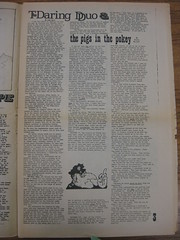The Rag: Articles
The Daring Duo
by John Muir
The Rag, September 29, 1969, Volume 3, Number 31; p.3

A new law office is opening. So what you say? My reaction too, usually. Who’s going to get excited about the addition of another lawyer who won’t even spring you form jail for less than $50? Or who demands $500 before he even begins working to represent you in court for your bust? Who needs another lawyer like that?
We don’t. But Jim Simons and Cam Cunningham don’t plan to practice that kind of law. It is their intention to serve the movement and the community as best they can. Jim has been involved in this kind of practice, which has become known as “movement law”, before. In January, 1968, after becoming disenchanted with his job at OEO, Jim decided to test the feasibility of accepting cases, particularly those of a political nature, which might not be what lawyers call “fee-generating”.
A high percentage of the cases which Jim took were involved with the draft. He successfully represented Enrique Madrid, an activist who had mailed his draft card to the Department of Justice along with hundreds of other people as part of a nationwide protest against the Selective Service System. Although Simons finally won the case on the grounds that the SSS had violated the due process clause of the Constitution in its attempts to induct Madrid, other aspects of the case were important in addition to the victory. Simons points out that this case was the first in Texas in which the defense made a serious attempt to build a case which could win. Until that time the goal of lawyers handling draft cases had been to “plead them out”, a lawyers’ term for compromise. It was significant; also that Madrid was an activist whose political position was well known both to the court and to the Selective Service.
Jim was involved, often daily, in attempting to counter the harassment of Larry Jackson and Austin SNCC. He represented Dick Reavis, Bob White, et al, in the shooting incident with Reavis’ landlady. He made numerous trips to Killeen to assist organizers of the Oleo Strut and soldiers at Ft. Hood.
Perhaps his biggest effort was expended on behalf of those were were busted in the Weedon demonstration in May, 1968. It was the suit which he filed in Federal court which delayed trail of the demonstrators until this past May. As the initial attorney of record, Jim was required to hassle with all of the minor details involved in defending fourty-two people charged with the same offense. In the end, Jim represented about half of the demonstrators in court. All of this work without pay.
Jim quite likely would not be practicing law right now if cam Cunningham had not returned to Austin. After graduating from law school, Cam spent more than a year in Window Rock, Arizona, working in the Navajo Legal Services Program. He came back to Austin last fall, anxious to relate his talents as a lawyer to the needs of the movement. With this goal in mind, he helped organized the Conference on Legal Services for Political Dissidents, a three-day meeting held in Wimberly, Texas.
One result of the conference was an abortive attempt to form a program to be known as “Movement Legal Services”. Cam was chosen to travel around the state and form committees of lawyers to represent movement groups in their own area. On the surface, the program appears to have failed, insofar as no functioning committees emerged. But the movement’s need for sympathetic representation became more apparent than ever to Cam.
At this time, Jim Simons was the only lawyer in Texas who was meeting the needs of the movement in a way which Cam could admire. But Jim wasn’t making enough money to live on and was on the verge of ending his practice.
Still undecided about what to do, Cam took the Texas Bar Exam early in the summer. By this time Jim had suspended his practice of law. With the Bar Exam past but the results not yet in, Cam decided to spend part of his vacation reviewing the Texas Penal Code Revision Project and attending a conference sponsored by the Southern Legal Action Movement. He convinced Jim to go with him.
The conference was notable in many ways, but most important for Cam and Jim was the relationship which they established with a group of New York lawyers who call themselves the law commune. Here was the model which b both had been looking for. The members of the law commune operate their practice as a collective, sharing both in decisions about what direction the practice will take and sharing also in the money made from generating cases. To Cam and Jim, it appeared that the lawyers in the law commune had found the best way to integrate the practice of law with their politics and their life-style.
Jim Simons and Cam Cunningham will be practicing law with the model of the law commune in mind. Such a practice presupposes one thing – that there is a community to serve. A community, in turn, takes care of its own. Jim quit once in frustration. Lawyers are only human. They need money to live on like the rest of us. Like the rest of us, they need to feel part of a community, of a movement. Not just to be used.
Jim, Cam, and their administrative assistant, Julie Howell, will open their office at 1201 W. 24th suite L on Wednesday, October 1. If you already know them, go by and see them Wednesday. If you don’t, go and meet them.
First 12 issues of The Rag are available online.